High-Efficiency Broadband Planar Array Antenna with Suspended Microstrip Slab for X-Band SAR Onboard Small Satellites
Abstract
:1. Introduction
2. Proposed Array Antenna Configuration
2.1. Antenna Geometry
- Antenna Size: (Az × El) 371 mm × 276 mm
- Gain ≥ 28.5 dBi
- Frequency: 9.65 GHz [BW: 300 MHz]
- Efficiency > 50%
- Reflection Coefficient ≤ −15 dB
- Beamwidth: Az > 4.0°, El > 5.8°
- Sidelobe Level: Az < −13 dB, El < −13 dB
- Polarization: linear (Vertical)
- Port: SMA (F)
- Antenna Panel Launch Mass: 0.53 kg
2.2. Antenna Element Design
2.3. Array Design
2.4. Feeding Network
3. Results and Discussion
4. Conclusions
Author Contributions
Funding
Institutional Review Board Statement
Informed Consent Statement
Data Availability Statement
Acknowledgments
Conflicts of Interest
References
- Elhefnawy, M.; Sumantyo, J.T.S. A review on designing antenna arrays for long range synthetic aperture radar. In Proceedings of the 2016 International Workshop on Recent Advances in Robotics and Sensor Technology for Humanitarian Demining and Counter-IEDs (RST), Cairo, Egypt, 27–30 October 2016. [Google Scholar]
- Akbar, P.R.; Saito, H.; Zhang, M.; Hirokawa, J.; Ando, M. Parallel-plate slot array antenna for deployable SAR antenna onboard small satellite. IEEE Trans. Antennas Propag. 2016, 64, 1661–1671. [Google Scholar] [CrossRef]
- Wang, W.; Zhang, H.-T.; Zhang, Z.-H.; Liang, X. Broadband antenna array for SAR applications. In Proceedings of the 2014 IEEE Antennas and Propagation Society International Symposium (APSURSI), Memphis, TN, USA, 6–11 July 2014. [Google Scholar]
- Kurniawan, F.; Sumantyo, J.T.S.; Ito, K.; Kuze, H.; Gao, S. Patch antenna using rectangular centre slot and circular ground slot for circularly polarized synthetic aperture radar (CP-SAR) application. Prog. Electromagn. Res. 2017, 160, 51–61. [Google Scholar] [CrossRef] [Green Version]
- Kumar, N.K.T.R.N.; Sreenivasan, M.; Thomas, K.G.; Rao, P.H. A multilayer X-band FMCW-SAR microstrip array. In Proceedings of the 2016 International Conference on Wireless Communications, Signal Processing and Networking (WiSPNET), Chennai, India, 23–25 March 2016. [Google Scholar]
- Islam, M.F.; Ali, M.A.M.; Majlis, B.Y.; Misran, N. Dual band microstrip patch antenna for SAR applications. Aust. J. Basic Appl. Sci. 2010, 4, 4585–4591. [Google Scholar]
- Balanis, C.A. Antenna Theory: Analysis and Design, 4th ed.; Wiley-Blackwell: Hoboken, NJ, USA, 2016; ISBN 9781118642061. [Google Scholar]
- Strassner, B. Lightweight, wideband, amplitude-tapered, linearly-polarized, dual-axis monopulse, Ku-band patch antenna array for SAR. In Proceedings of the 2007 IEEE Antennas and Propagation Society International Symposium, Honolulu, HI, USA, 9–15 June 2007. [Google Scholar]
- Kong, L.; Xu, X. A Compact Dual-Band Dual-Polarized Microstrip Antenna Array for MIMO-SAR Applications. IEEE Trans. Antennas Propag. 2018, 66, 2374–2381. [Google Scholar] [CrossRef]
- Farran, M.; Boscolo, S.; Locatelli, A.; Capobianco, A.-D.; Midrio, M.; Ferrari, V.; Modotto, D. High-gain printed monopole arrays with low-complexity corporate-feed network. IET Microw. Antennas Propag. 2017, 11, 1616–1621. [Google Scholar] [CrossRef]
- Maharjan, J.; Choi, D.-Y. Four-element microstrip patch array antenna with corporate-series feed network for 5G communication. Int. J. Antennas Propag. 2020, 2020, 8760297. [Google Scholar] [CrossRef]
- Mohamed, B.T.; Ammor, H. A 16-elements Corporate-series Feed Rectangular Patch Antenna Array at 28 GHz, for future 5G applications. In Proceedings of the 2019 International Conference on Wireless Technologies, Embedded and Intelligent Systems (WITS), Fez, Morocco, 3–4 April 2019; pp. 1–4. [Google Scholar]
- Garg, R. Microstrip Antenna Design Handbook; Artech House: Norwood, MA, USA, 2000; ISBN 9780890065136. [Google Scholar]
- Kumar, G.; Ray, K.P. Broadband Microstrip Antennas; Artech House: Norwood, MA, USA, 2002; ISBN 9781580531641. [Google Scholar]
- Jam, S.; Malekpoor, H. Analysis on wideband patch arrays using unequal arms with equivalent circuit model in X-band. IEEE Antennas Wirel. Propag. Lett. 2016, 15, 1861–1864. [Google Scholar] [CrossRef]
- Pyne, B.; Saito, H.; Akbar, P.R.; Hirokawa, J.; Tomura, T.; Tanaka, K. Development and performance evaluation of small SAR system for 100-kg class satellite. IEEE J. Sel. Top. Appl. Earth Obs. Remote Sens. 2020, 13, 3879–3891. [Google Scholar] [CrossRef]
- Alibakhshikenari, M.; Virdee, B.S.; See, C.H.; Abd-Alhameed, R.; Falcone, F.; Limiti, E. Array Antenna for Synthetic Aperture Radar Operating in X and KuBands: A Study to Enhance Isolation Between Radiation Elements. In Proceedings of the 12th European Conference on Synthetic Aperture Radar, Aachen, Germany, 4–7 June 2018. [Google Scholar]
- Qu, X.; Zhong, S.; Zhang, Y.; Wang, W. Design of an S/X dual-band dual-polarised microstrip antenna array for SAR applications. IET Microw. Antennas Propag. 2007, 1, 513–517. [Google Scholar] [CrossRef]
- Capece, P.; Lucci, L.; Pelosi, G.; Porfilio, M.; Righini, M.; Steffè, W. A Multilayer PCB Dual-Polarized Radiating Element for Future SAR Applications. IEEE Antennas Wirel. Propag. 2014, 13, 297–300. [Google Scholar] [CrossRef]
- Zhao, X.; Tian, B.N.; Yeo, S.P.; Ong, L.C. Design of low-profile broadband dual-polarized integrated patch sub-array for X-band SAR payload on small satellite. In Proceedings of the 2016 IEEE-APS Topical Conference on Antennas and Propagation in Wireless Communications (APWC), Cairns, Australia, 19–23 September 2016; pp. 27–29. [Google Scholar]
- Kothapudi, V.K.; Kumar, V. Hybrid-fed shared aperture antenna array for X/K-band airborne synthetic aperture radar applications. IET Microw. Antennas Propag. 2021, 15, 93–102. [Google Scholar] [CrossRef]
- Mao, C.-X.; Gao, S.; Luo, Q.; Rommel, T.; Chu, Q.-X. Low-cost X/ku/Ka-band dual-polarized array with shared aperture. IEEE Trans. Antennas Propag. 2017, 65, 3520–3527. [Google Scholar] [CrossRef]
- Mao, C.-X.; Gao, S.; Wang, Y.; Chu, Q.-X.; Yang, X.-X. Dual-band circularly polarized shared-aperture array for C-/X-band satellite communications. IEEE Trans. Antennas Propag. 2017, 65, 5171–5178. [Google Scholar] [CrossRef]
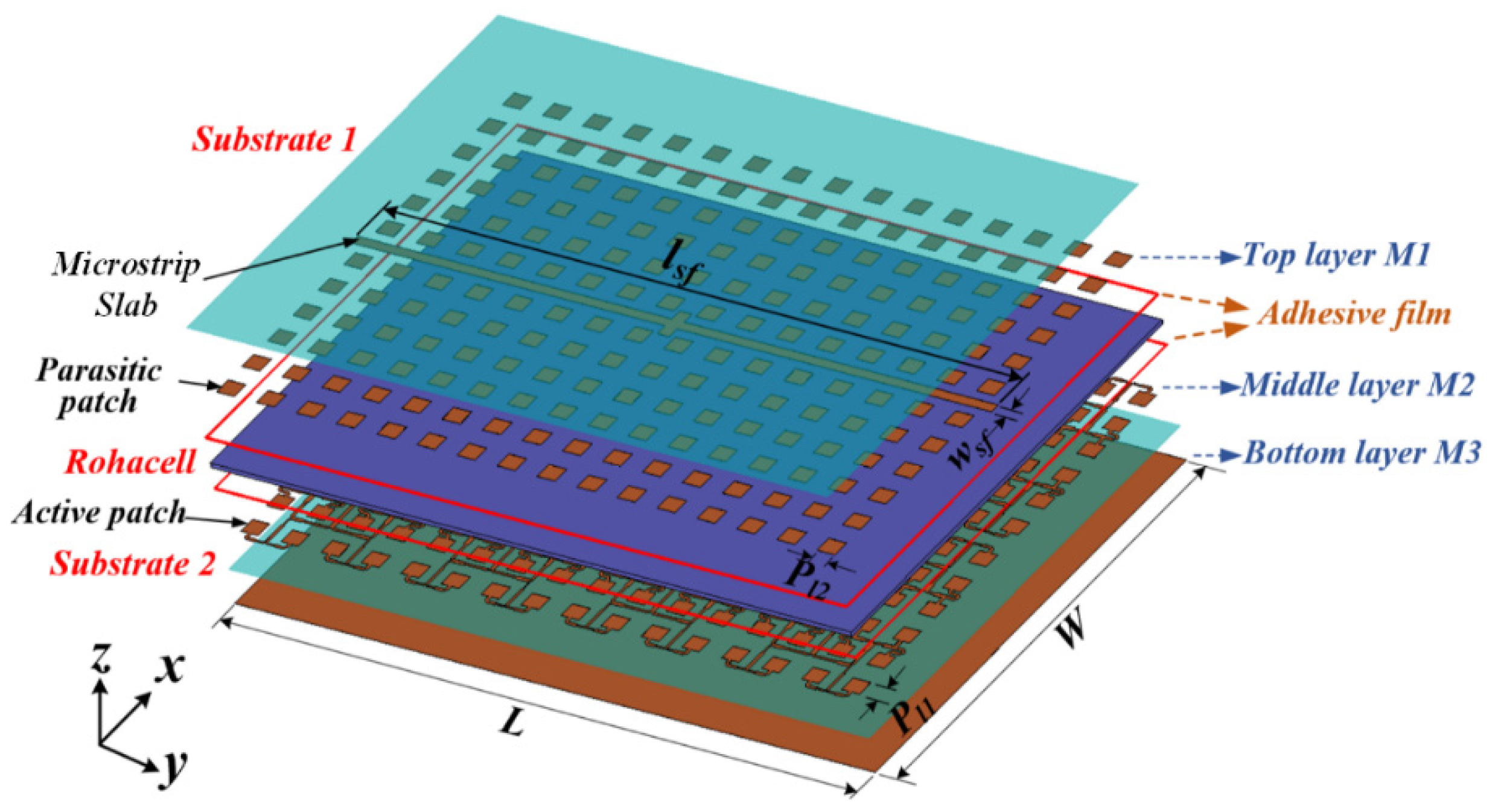

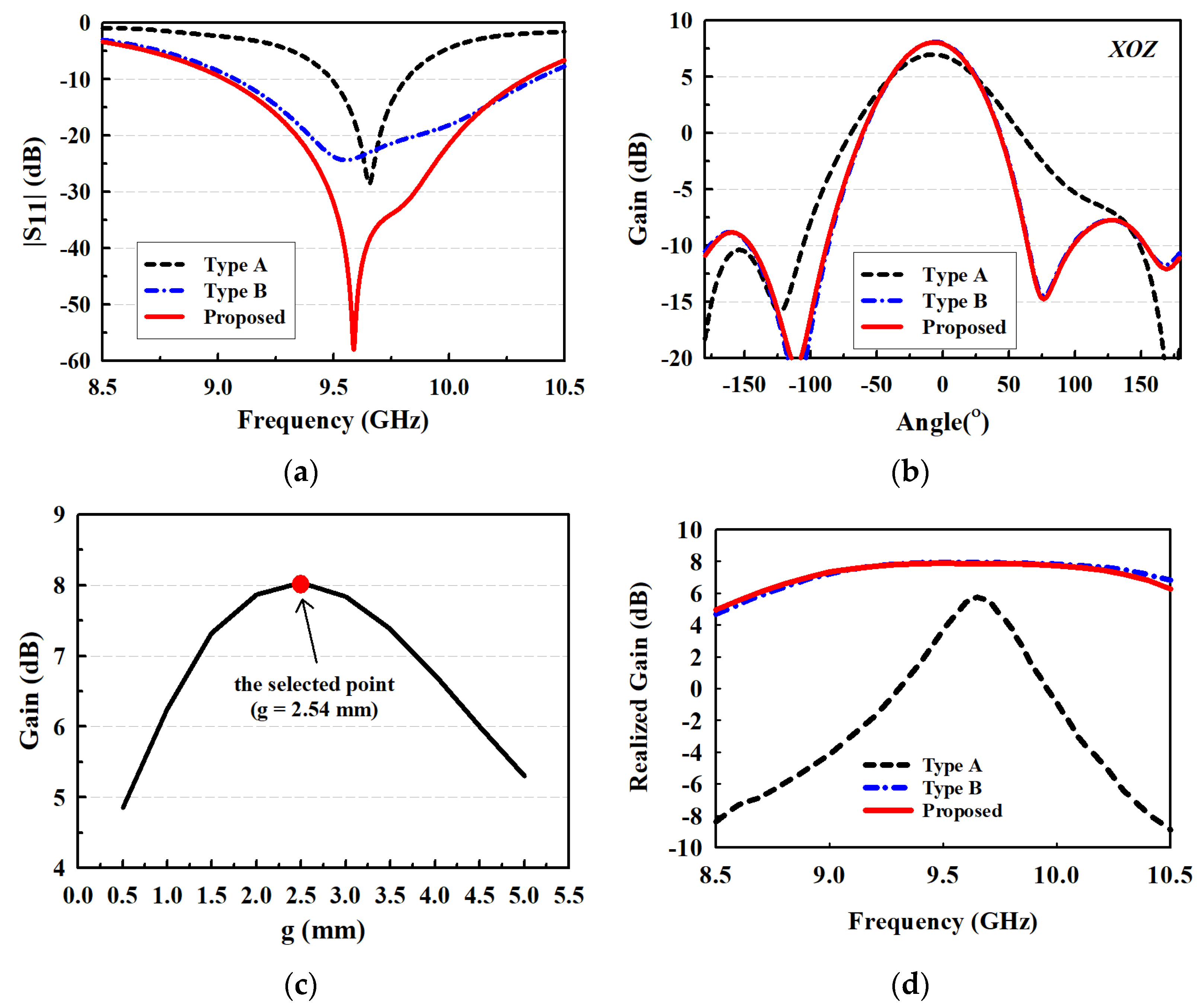

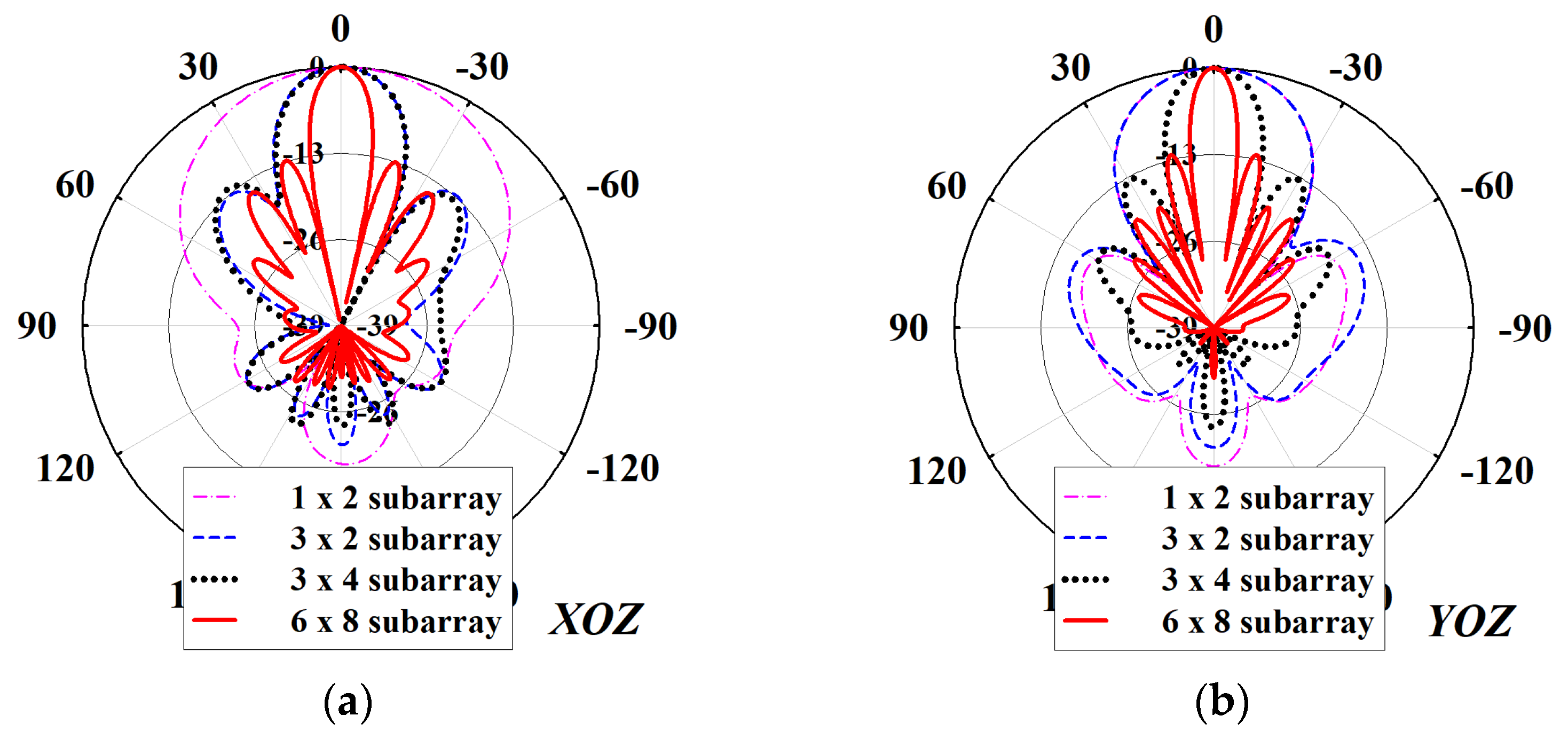

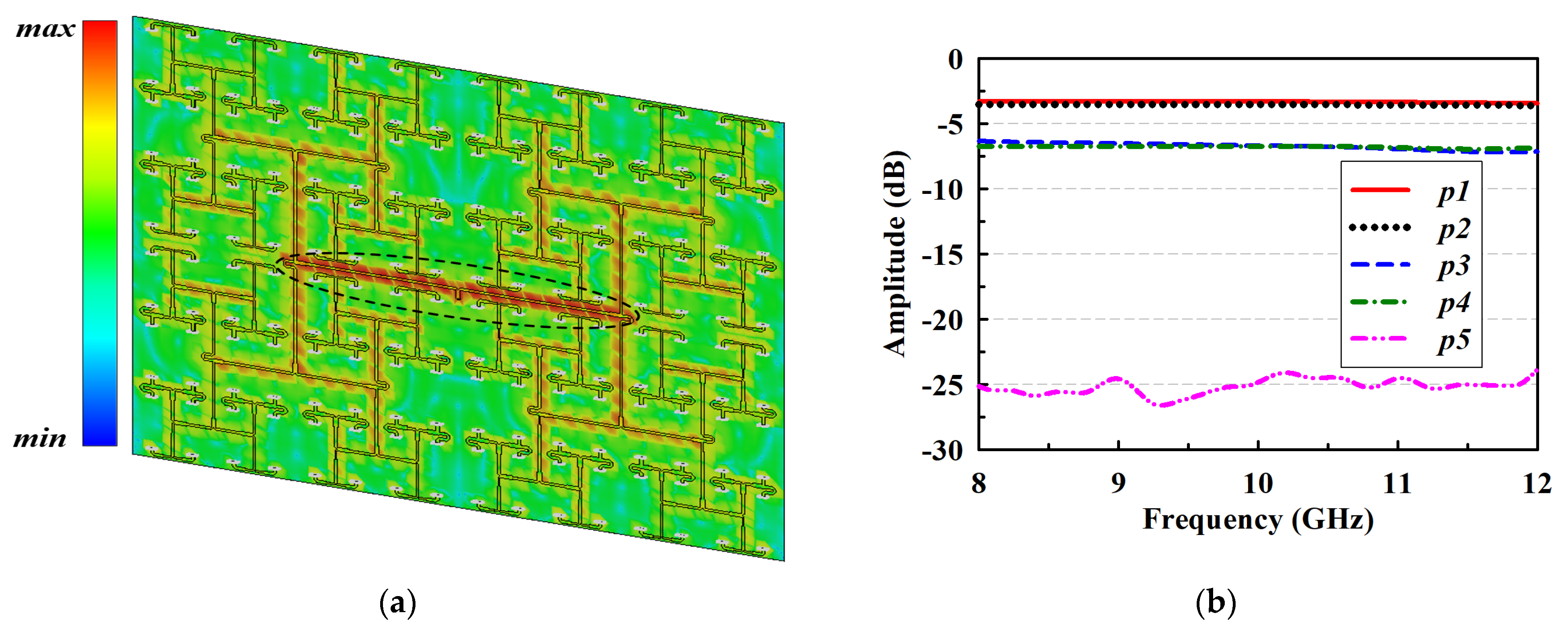

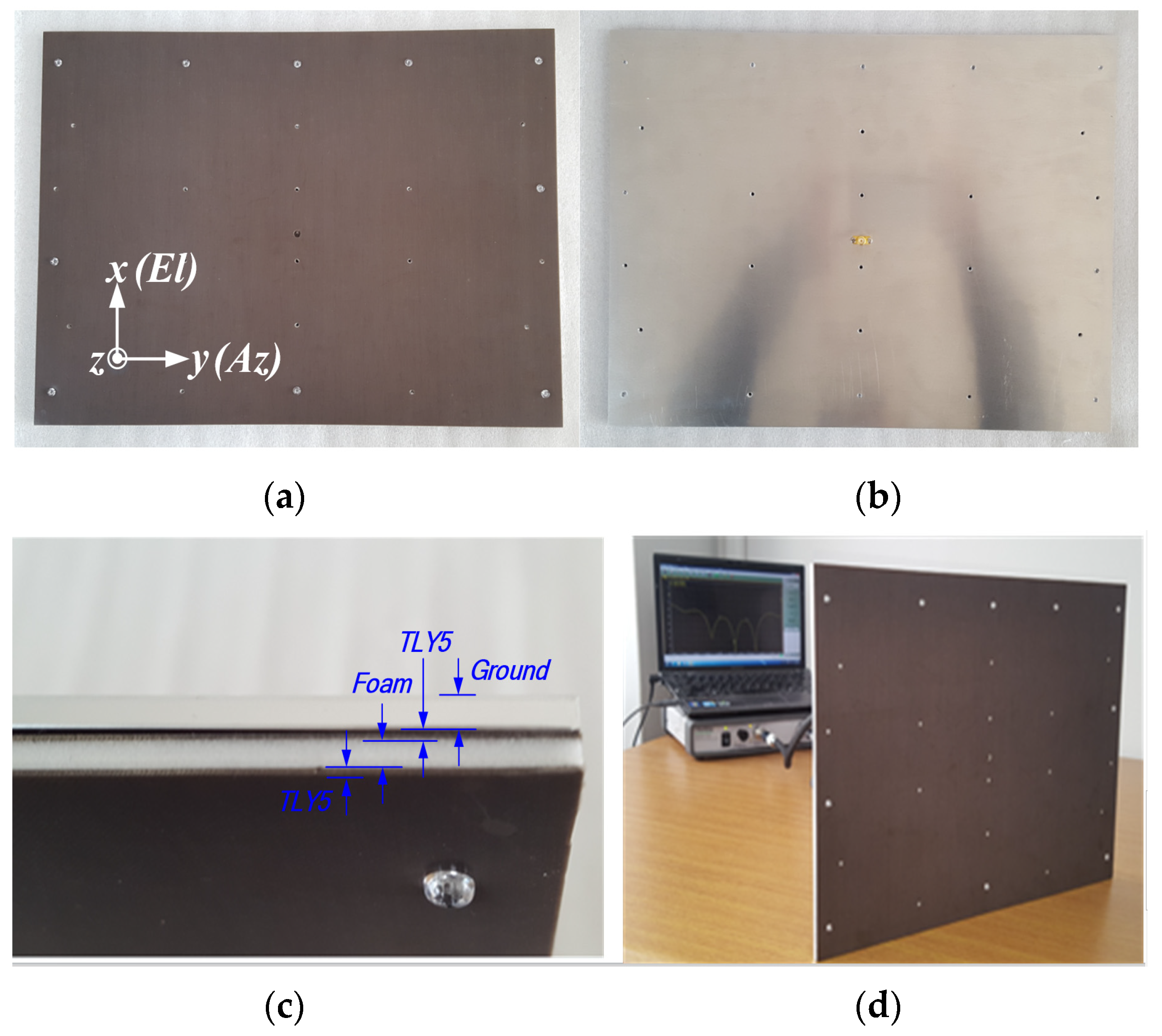

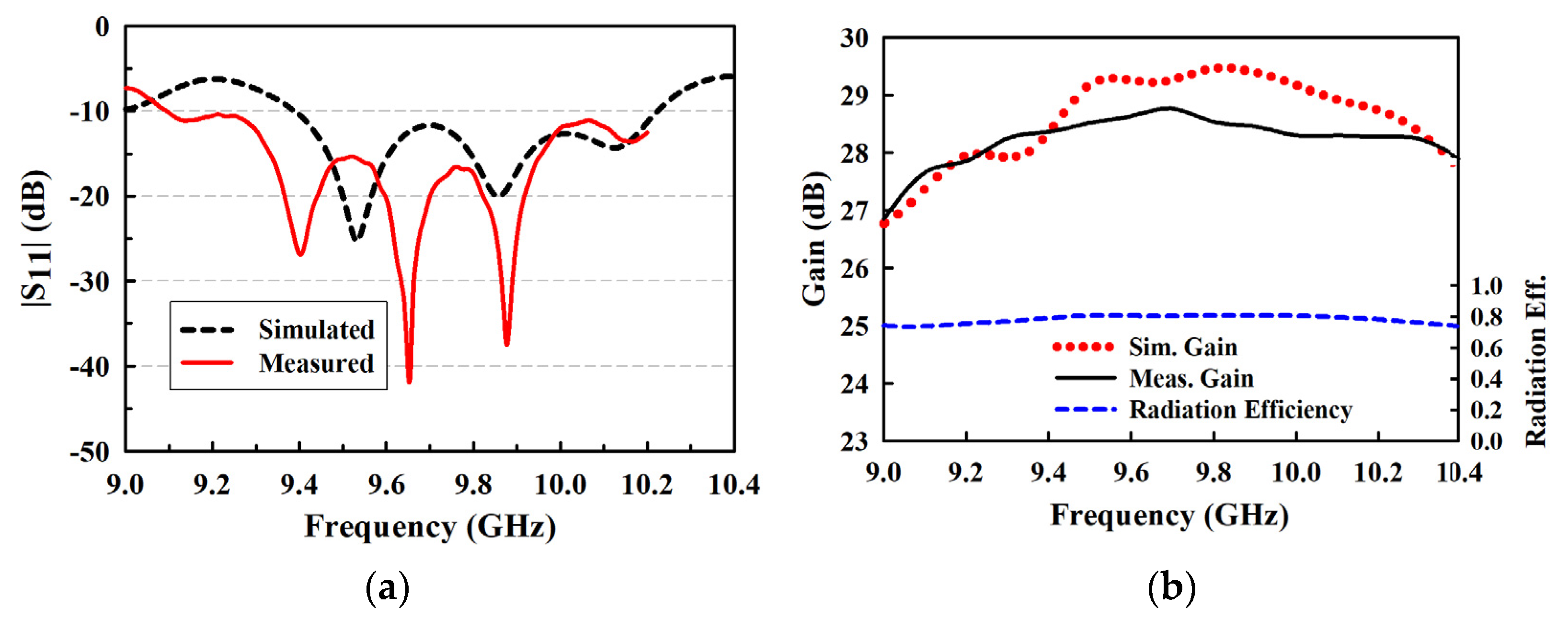
| Antenna | Frequency Band | Array Size | Antenna Size (mm) | Polarization | Bandwidth | Max. Gain | Antenna Efficiency | Sidelobe Level |
|---|---|---|---|---|---|---|---|---|
| [2] | X | 24 × 32 | 678 × 700 | Circular | 1.3% | 34.9 dBi | 54% | 11 dB |
| [9] | X and Ku | 4 × 6 | 77 × 79 | Horizontal and Vertical | 30%, 23% X-band, Ku-band | 14.1 dBi, X-band. 12.7 dBi, Ku-band | 80% | 6 dB |
| [18] | X | 1 × 6 | 20 × 20 | Horizontal and Vertical | 16% | 8 dBi | - | - |
| [19] | X and S | S-band 2 × 1 X-band 7 × 4 | 100 × 140 | Horizontal and Vertical | 5% in both X- and S-bands | - | - | 10 dB |
| [20] | X | 1 × 8 | 150 × 24 | Horizontal and Vertical | 7.8% | 15 dBi | - | 25 dB |
| [21] | X and K | 6 × 6 | 150 × 150 | Horizontal and Vertical | 10.36% ~X-band 1.45% ~K-band | 24.2 dBi, X-band and 17.4 dBi at K-band | 85% | 18 dB |
| [22] | X, Ku and Ka | X-band 2 × 2 Ku-band 4 × 4 Ka-band 4 × 4 | - | Horizontal and Vertical | 3.6% ~X-band 6.7% ~Ku-band 5.3% ~Ku-band | 19.2 dBi | 80% | 12 dB |
| [23] | C and K | C-band 2 × 2 X-band 4 × 4 | - | Circular | 14.5 dBi, C-band and 17.5 dBi, X-band | 55% | 15 dB | |
| Proposed | X | 12 × 16 | 371 × 276 | Vertical | 12.39% | 28 dBi | 51.3% | 13 dB |
Publisher’s Note: MDPI stays neutral with regard to jurisdictional claims in published maps and institutional affiliations. |
© 2021 by the authors. Licensee MDPI, Basel, Switzerland. This article is an open access article distributed under the terms and conditions of the Creative Commons Attribution (CC BY) license (https://creativecommons.org/licenses/by/4.0/).
Share and Cite
Anim, K.; Danuor, P.; Park, S.-O.; Jung, Y.-B. High-Efficiency Broadband Planar Array Antenna with Suspended Microstrip Slab for X-Band SAR Onboard Small Satellites. Sensors 2022, 22, 252. https://doi.org/10.3390/s22010252
Anim K, Danuor P, Park S-O, Jung Y-B. High-Efficiency Broadband Planar Array Antenna with Suspended Microstrip Slab for X-Band SAR Onboard Small Satellites. Sensors. 2022; 22(1):252. https://doi.org/10.3390/s22010252
Chicago/Turabian StyleAnim, Kyei, Patrick Danuor, Seong-Ook Park, and Young-Bae Jung. 2022. "High-Efficiency Broadband Planar Array Antenna with Suspended Microstrip Slab for X-Band SAR Onboard Small Satellites" Sensors 22, no. 1: 252. https://doi.org/10.3390/s22010252
APA StyleAnim, K., Danuor, P., Park, S.-O., & Jung, Y.-B. (2022). High-Efficiency Broadband Planar Array Antenna with Suspended Microstrip Slab for X-Band SAR Onboard Small Satellites. Sensors, 22(1), 252. https://doi.org/10.3390/s22010252








